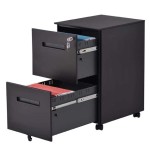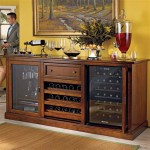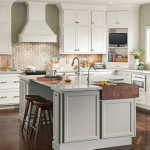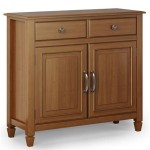How to Organize a Small Kitchen Without Cabinets
Organizing a small kitchen lacking cabinets presents unique challenges. The absence of built-in storage solutions necessitates innovative approaches to maximize available space and maintain a functional cooking environment. Effective organization relies on a strategic combination of alternative storage methods, decluttering techniques, and a commitment to maintaining a minimalist approach.
1. Embrace Open Shelving Strategically
Open shelving becomes a crucial element in a cabinet-free kitchen. However, poorly implemented open shelving can lead to a cluttered and visually overwhelming space. The key is strategic placement and careful curation of items displayed.
Consider installing shelves vertically to utilize wall space effectively. Different shelf depths can accommodate various items, from shallow shelves for spices and small jars to deeper shelves for plates and bowls. Wood, metal, or glass shelves can complement different kitchen styles. Ensure the shelves are securely mounted to handle the weight of stored items.
Items stored on open shelves should be both functional and aesthetically pleasing. Matching sets of dishes, neatly stacked bowls, and uniform jars containing dry goods contribute to a clean and organized appearance. Avoid overcrowding shelves with unnecessary items or items that create visual clutter. Frequently used items should be readily accessible, while less frequently used items can be stored higher up.
Labeling containers and jars helps maintain organization and ensures that contents are easily identifiable. Uniform labels create a cohesive look and minimize visual distractions. Regular dusting and cleaning of open shelves are essential to prevent dust buildup and maintain a tidy appearance.
The placement of open shelves should also be considered in relation to workflow and frequently used appliances. Position shelves near the stovetop for easy access to spices and cooking oils, or near the sink for convenient storage of dishes and cleaning supplies.
2. Utilize Wall Space with Hanging Storage Solutions
Wall space is a valuable asset in a small, cabinet-free kitchen. Hanging storage solutions maximize vertical space and keep countertops clear, creating a more spacious and organized environment.
Consider installing a pegboard to hang pots, pans, utensils, and other kitchen tools. Pegboards are highly customizable and allow for flexible arrangement of items. Hooks and other accessories can be easily repositioned to accommodate changing storage needs. Ensure the pegboard is securely mounted to the wall and that hooks are strong enough to support the weight of hanging items.
Magnetic knife strips provide a safe and space-saving solution for storing knives. They keep knives within easy reach while freeing up drawer space. Choose a magnetic strip made of high-quality materials and ensure it is securely mounted to the wall.
Hanging baskets can be used to store fruits, vegetables, and other produce. This not only saves counter space but also allows for better air circulation, which can help prolong the shelf life of certain items. Choose baskets made of breathable materials such as wire or wicker.
Over-the-door organizers can be used to store spices, cleaning supplies, or other small items. These organizers are easy to install and provide additional storage space without requiring any permanent fixtures. Choose an over-the-door organizer that is specifically designed for kitchen use and that can accommodate the weight of the items being stored.
Hooks can be used to hang dish towels, aprons, and other kitchen linens. Install hooks near the sink or stovetop for easy access. Choose hooks that are strong and durable and that match the overall aesthetic of the kitchen.
3. Maximize Countertop Space through Decluttering and Organization
Countertop space is a premium commodity in a small kitchen. Maintaining clear and clutter-free countertops is crucial for creating a functional and visually appealing cooking environment.
The first step is to declutter countertops by removing any unnecessary items. Appliances that are rarely used should be stored away. Items that have accumulated on the countertops over time should be evaluated and either stored away or discarded.
Designate specific areas on the countertops for different tasks. For example, one area can be designated for food preparation, another for serving, and another for storing frequently used items. This helps maintain order and prevents countertops from becoming cluttered.
Use countertop organizers to group similar items together. Utensil holders, knife blocks, and spice racks help keep items organized and within easy reach. Choose organizers that are appropriately sized for the available countertop space and that complement the overall aesthetic of the kitchen.
Vertical storage solutions, such as tiered shelves and stacking containers, can help maximize countertop space. These solutions allow for storing multiple items in a small area. Choose solutions that are durable and easy to clean.
Consider using portable kitchen islands or carts to provide additional countertop space and storage. These islands or carts can be moved around the kitchen as needed and can be stored away when not in use. Choose an island or cart that is appropriately sized for the kitchen and that provides adequate storage space.
Regularly clean countertops to prevent crumbs, spills, and other messes from accumulating. This not only keeps the kitchen looking clean and organized but also prevents the growth of bacteria and other harmful microorganisms.
4. Utilize Under-Sink Space Effectively
The space under the kitchen sink often becomes a catch-all for cleaning supplies and other miscellaneous items. However, with proper organization, this space can be effectively utilized to store a variety of kitchen essentials.
Start by decluttering the under-sink area, removing any unnecessary items. Discard empty containers, expired cleaning products, and other items that are no longer needed. This creates more space for organizing the remaining items.
Install under-sink organizers to maximize the available space. These organizers come in a variety of styles, including pull-out shelves, tiered organizers, and door-mounted racks. Choose organizers that are appropriately sized for the under-sink area and that meet specific storage needs.
Use clear storage containers to group similar items together. This helps prevent clutter and makes it easier to find what is needed. Label the containers so that the contents are easily identifiable.
Store cleaning supplies in a caddy or basket for easy portability. This allows for easily moving cleaning supplies around the kitchen as needed. Choose a caddy or basket that is durable and easy to clean.
Install a tension rod to hang spray bottles and other cleaning products. This helps keep the under-sink area organized and prevents bottles from falling over. Ensure the tension rod is securely mounted and that it can support the weight of the hanging items.
Consider using a shelf liner to protect the bottom of the under-sink cabinet from spills and leaks. This helps prolong the life of the cabinet and prevents damage from moisture.
Regularly clean the under-sink area to prevent spills and messes from accumulating. This helps maintain a clean and organized environment and prevents the growth of mold and mildew.
5. Employ Mobile Storage Solutions
In a small kitchen without cabinets, flexibility is key. Mobile storage solutions provide the ability to adapt the kitchen layout to suit various needs and tasks.
Rolling carts are a versatile option for adding storage and workspace. Choose a cart with multiple shelves or drawers to maximize storage capacity. Carts can be used to store pots, pans, utensils, or even dry goods. When not in use, they can be easily moved out of the way to create more space.
Kitchen islands with wheels offer a larger surface area for food preparation and can also provide significant storage space. Look for islands that have drawers, shelves, or cabinets for storing various kitchen items. The mobility of the island allows for adjusting the kitchen layout to suit different cooking tasks.
Folding tables can be used as temporary workspaces or serving areas. When not needed, they can be folded up and stored away, saving valuable space. Choose a folding table that is lightweight and easy to set up and take down.
Consider using stackable storage containers or bins for storing dry goods, pantry items, or cleaning supplies. These containers can be easily moved around the kitchen as needed and can be stacked to maximize vertical space. Look for containers with clear lids for easy identification of contents.
When selecting mobile storage solutions, consider the overall style of the kitchen and choose items that complement the existing décor. Also, consider the size and weight of the items being stored and choose solutions that are sturdy and durable.

7 Super Easy Ways To Arrange A Kitchen Without Cabinet

Kitchen Tour How To Organise Unfurnished Without Cabinets Youtube Diy Decor Modern

13 Miracle Solutions For Organizing A Kitchen Without Cabinets

7 Super Easy Ways To Arrange A Kitchen Without Cabinet

13 Miracle Solutions For Organizing A Kitchen Without Cabinets

7 Super Easy Ways To Arrange A Kitchen Without Cabinet

How To Have Open Shelving In Your Kitchen Without Daily Staging The Inspired Room

Pantry Alternatives No Solutions For Small Kitchens Decluttering Your Life Kitchen Without Storage

Some New Ideas To Organize A Small N Kitchen With Without Cabinets Youtube

7 Super Easy Ways To Arrange A Kitchen Without Cabinet








